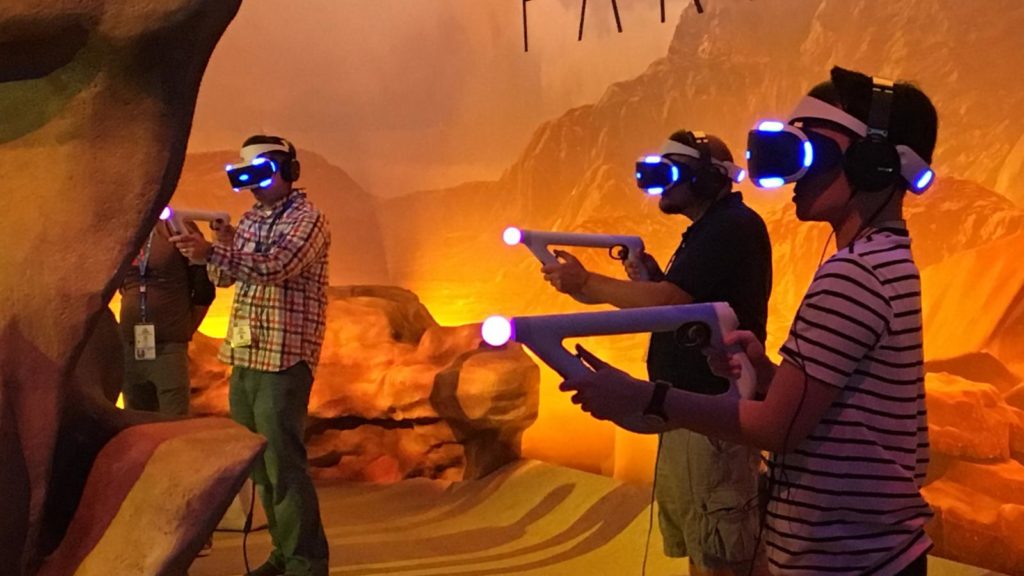Sony dedicated much of its E3 booth to PlayStation VR, which will launch October 13 for $400. With 50 games shipping in its launch window, the leading game console maker is betting on the future of virtual reality.
Ian Hetherington, CEO of eeGeo, was the founder and chairman of Evolution Studios (Motorstorm, DriveClub). He became involved in the early development of Project Morpheus (PlayStation VR) after Sony acquired his Liverpool-based studio.
With HTC Vive, Oculus Rift, Samsung Gear VR, StarVR, and PlayStation VR all on display with a variety of games at E3 this year, Hetherington talks to [a]listdaily about the upcoming 4K upgrade for PlayStation VR and the evolving landscape of virtual reality as a gaming and entertainment platform in this exclusive interview.
How were you involved in the development of PlayStation VR?
Evolution had a very active R&D group employing specialists with advanced 3D technology experience, often cutting-edge. These specialist areas included stereoscopic visioning from advanced Euro Fighter HUD development, point cloud manipulation and sampling technologies, Lidar, etc.
Sony acquired Evolution in 2007, and these technologies were applied to driving game simulation and PlayStation’s early stage VR experimentation.
How did input from Sony’s game development teams influence the headset?
Sony was excellent. While a global studio resource operates under strict commercial business objectives, they allow the studios to experiment in diverse ways, which ultimately adds to the IP portfolio and creates an edge in the market—Eyetoy, Buzz, etc. This is a healthy approach which preserves the integrity and interest of studios, particularly those that are a result of acquisition. Most of the successful studios I have worked with, and there are many, live to innovate.
How did you design PlayStation VR to be upgradable to 4K?
This occurred after my time with the company. Due to a few dedicated pioneers, the VR head-mounted display specification has evolved to a base specification for a sustainable VR experience—head movement to retina latency, movement sensor accuracy, resolution, more than 90 frames per second, etc. Each and every one of these is fundamental to basic VR viability. 4K is becoming part of this basic specification and you will see it as a must-have for the next generation of VR-enabled mobile devices.
What do you think will be the PlayStation VR’s impact on the overall VR ecosystem?
By definition, the majority of console content will be games related. This defines itself as niche when compared to the mobile/VR ecosystem, which will run to tens of millions of users, and more importantly, location-based VR.
What impact are the new PC, console, and mobile VR headsets having on entertainment?
You have to differentiate between entertainment as in Hollywood and console gaming, and the mobile sector. There is no doubt that there will be impressive “experiences” on console, however, there is plenty of research which supports the fact that you do not need ultra-high resolution to create immersion and the mobile experience is more than capable of producing this.
How is this technology opening up opportunities for brands and sponsors?
We’re in the early days as we are just laying down the foundational layers of what the VR/AR experience will be capable of delivering. Much like the early days of 3D over 2D, this is quite a shift in user expectation. The quest right now is to deliver platforms that allow content creators to experiment easily and quickly.
What does eeGeo do?
EeGeo has developed a technology to map the world in 3D. We produce a country-by-country model of entire geographies including roads, buildings, terrain, digital height, etc. Uniquely, we model not only the outside of buildings but also interiors. We do this in a totally seamless way. This is a foundational layer for VR, and particularly AR. If you want to position data in the real world, then the eeGeo platform is the perfect platform to author and position that data accurately.
We have proven the platform with over five million downloads to date, and a commercial base of key customers in a variety of sectors.
We are already VR enabled on Cardboard architectures, and scaling up in resolution and features is relatively easy. We have a substantial backlog of platform deliverables, which will put us far ahead of the curve in VR and AR mapping. We firmly believe our core technology differentiates us sufficiently from Google, Apple, etc. to make this a sustainable proposition. I have disrupted established markets in the past, and I see no reason to stop eeGeo from doing that again.
What do you think about mixed reality?
VR form factors will inevitably give way to mixed reality devices. I see VR as a stepping stone where experimentation is more open, but real-world use cases will dominate in time.
How do you see VR and mixed reality evolving over the next five years?
Exactly that: evolving. I see us quickly moving away from the current use cases for experiences and gaming, toward social, communication, and location-based services. This is a mirror world where data is key and discoverability and proximity are the primary indexes. There is much talk of intelligent buildings, Internet of Things, etc. At the moment, this is mostly concerned with data harvesting and not data usage.

